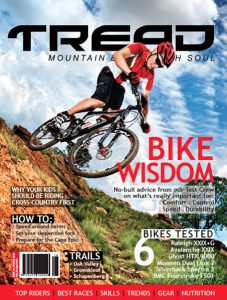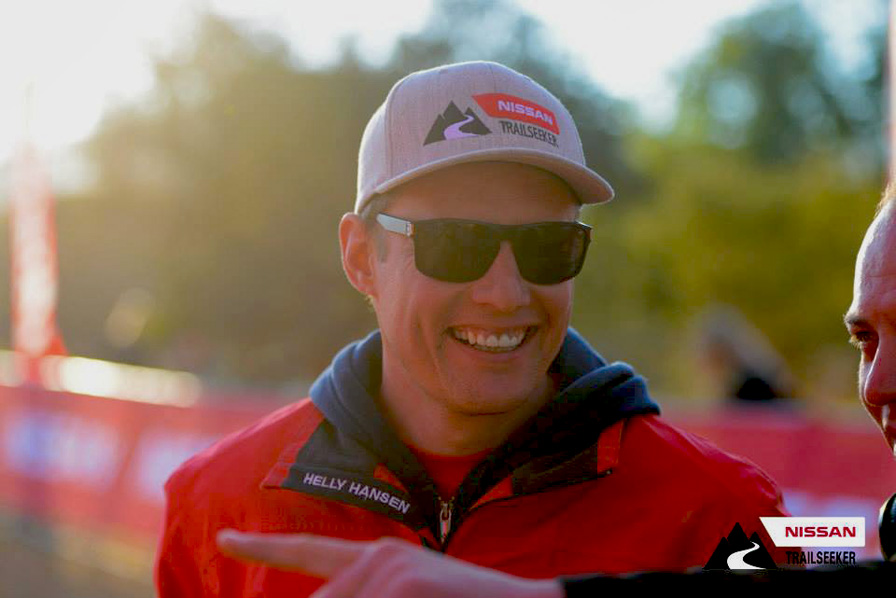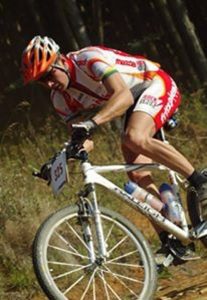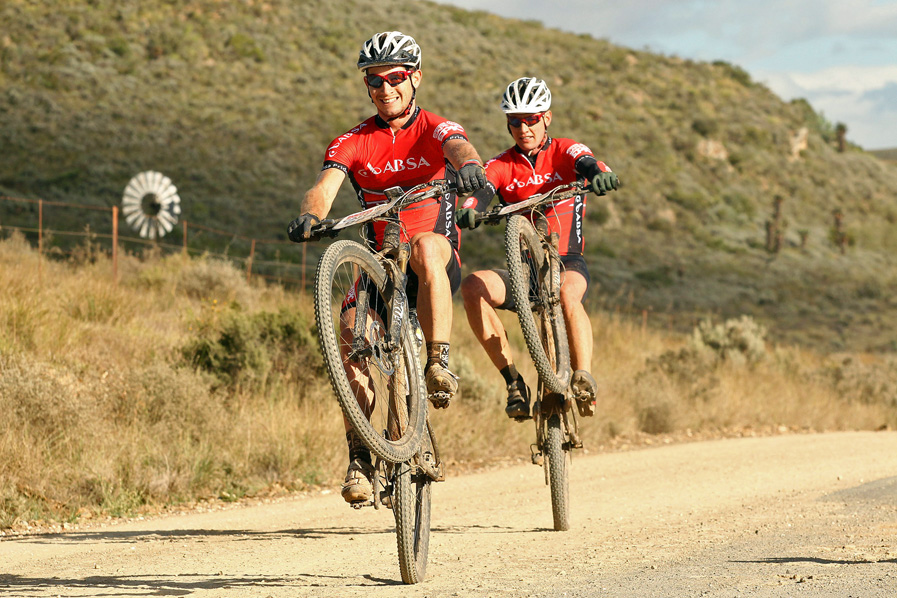
In my opinion, Fritz Pienaar is one of two men that sparked the growth and subsequent popularity of mountain biking in South Africa (the other is Cape Epic founder, Kevin Vermaak). Pienaar is the Director of Advendurance, the company that owns and organises the Ashburton Investments National MTB Series and the Nissan Trailseeker Series (both Gauteng and Western Cape). Advendurance mountain bike events are among the highest quality events in the world and cater for all fitness levels and ages of mountain bikers in South Africa.
Advendurance, under Pienaar’s leadership, also developed the SA Seeding system that seeds riders according to ability/fitness into appropriate start batches and runs a national ranking system based on the seeding index of each rider. Most events use this system because it makes organising a mountain bike race easier.
And more recently, Advendurance showed more innovation with their national series to create the most affordable two-day stage races at five of the 2017 Ashbhurton Investments Series events.
Pienaar is a former three-time SA Elite XCO champion and one of the most skilled mountain bikers you will ever ride with. He has been and remains one of the most influential people in South African mountain biking. Here’s how he answered our 10 burning questions…
By Sean Badenhorst
Photos: Zoon Cronje, Ben Burgh, Shaun Roy

As the Director of Advendurance, you were the person responsible for stating Advendurance’s case in the recent women’s Elite category prize money saga. Social media commentators, many of whom are unlikely to know you personally, were highly critical of you in particular. Do you take this kind of criticism personally?
I try not to take it personally, but it still bothers me a bit when people are just rude without knowing a person or all the facts. I read a proverb on a Huletts sugar packet recently, which said: “If you know yourself, then you’ll not be harmed by what is said about you.” I try to stand by this.
With regards to this issue, I was not trying to be discriminatory in any way, and did what I felt was fair. I had no gain in paying one party more than the other, and would love to see women’s cycling growing. But I also wanted what is fair for the men, who race in a super competitive environment.
This debate was blown out of proportion in a way, because I never had a fight with Ariane, but merely a civilised debate between two people who have a lot of respect for each other.
I am glad that Ashburton added to the budget to pay equal prize money without lowering the men’s prize money, so it ended well.
Following the women’s prize money saga, which obviously saw Ashburton Investments increase their investment in their series, there were just a handful of women competing for that equal prize money at Round 2 in Sabie. What are your thoughts on that and what do you think the solution is to attract more women to the National MTB Series?
The ladies field at Sabie was not the exception, but rather the norm, and that was the basis of my argument in the first place. The men’s field was very competitive as usual and riders like Karl Platt did not even make it into the top 10, while there were no more than three professional ladies on the start. We are therefore ending up with a situation where amateur ladies earn more prize money than many of the professional men. I hope the prize purse will assist with the growth of the women’s category, but doubt that it will make a real difference.
I do think that the women’s racing is growing and improving, but it will take time to get the same depth as the men’s field. Ladies like Robyn and Ariane are very professional and they are great ambassadors for the sport. They are doing good work in promoting the sport and getting youngsters into the sport (especially Ariane at the Spur events), so we are seeing the competitiveness pick up in the younger categories, so let’s hope it will come through to the senior categories over time.
Having been such a key figure in developing marathon and half-marathon racing to the healthy state it enjoys today, does it bother you when newcomers to mountain biking take so much of what they have for granted, considering what was on offer (or wasn’t on offer) before you started Advendurance?
I love seeing more people on bikes and newbies at event and am thankful that we have a healthy sport and that I can run a business from the events, so it does not bother me that it was not always this way.

There were very few sponsors when I was racing and barely any coverage, so I
did not see riding as a career. I wanted to be in the industry though and tried many things from importing, shops, online retail, administration systems and events and I am glad that some of it worked out, and that I can make a living from my passion.
It was great to also bring some sponsors to the sport and lift the profile of events and increase the coverage. This created many opportunities for the newer generation of pro riders with the influx of new sponsors.
Side note: It is a shame that most of this was undone by the few cheating riders who used banned substances. Many sponsors pulled out of teams and companies are now wary of associating with riders. I really hope that we can eradicate the bad elements and have a cleaner sport going forward.
Advendurance conceptualised and developed the SA Seeding system, which is now used by all established races for start seeding, something that has significantly improved mountain bike racing in this country. Is the system now fully refined, or do you still think there’s work to be done?
SA Seeding (SAS) was created out of a need back in 2008. Advendurance’s participation numbers grew quite well after we started the Nissan Trailseeker Series in Gauteng, but the routes could not accommodate the big batches of riders back then. We needed to either keep the events quite small or find a way of batching the riders in smaller groups with riders of similar ability, so we started SA Seeding.
SAS provided a service to the industry but there was not really a viable financial model behind it, so we decided to invest more into it and to make it a proper sports administration system, which can sell entries, do seeding, timing and batching as well as work out series standings/rankings. I do think we have a good product now, but we will probably never stop developing it, because there is a lot more we can do with it.
You once owned a few retail stores in Gauteng and was named as one of the people involved with organising the meeting between retailers and wholesalers to discuss cycle industry prices. This obviously became the price-fixing saga that only recently drew to a close. You were one of those that admitted guilt. Did you get out of retail as a result of the fallout from that?
I was actually not one of the parties who admitted guilt, but this case was a big factor in the decision to exit the retail industry. We received huge backlash for being involved in the meeting, and I lost my passion for the retail industry when that happened.
I was naïve and much younger at the time and should probably not have had the meeting with competitors or have discussed sensitive topics, but I am still not aware of any prices that were increased or margins which were changed. I certainly did not think it was wrong to have the meeting at the time, because it was all very open and transparent, and we invited all industry players in Gauteng. Cycling does not have a regulatory body that looks after matters and I did not see another way of voicing a concern. The meeting turned out to be mostly around the prescribed recommended retail prices that are set by wholesalers to retailers, and the competition commission saw this as anti-competitive.
I have learned a lot since then and know now that it is very dangerous to meet with competitors to discuss anything that relates to business, prices and profit.
South African MTB events, including your Advendurance events, are considered by international participants to be among the best they’ve ever competed in. What do you think makes the standard so high here in South Africa?
South Africans love competing in events and they love challenges, and we therefore have the biggest mass participation events in the world in many endurance sporting disciplines.
There are a huge number of people willing to participate in events, which resulted in many events being organised to satisfy the demand. This in turn gives participants a great choice of events to choose from, so organisers need to host exceptionally good events to stand out from the crowd. I actually think it is the basic business principles of supply and demand that ensure excellent events and good value.

You were the South African Cross Country (XCO) champion from 2000-2002. There was no national marathon championship back then. There were very few cross country marathon-style (XCM) events even. Was this part of what motivated you to start a national marathon series back in 2002?
I started the first Fritz Pienaar Cycles shop in 2001 with two partners (Heinrich Richter and Theo Grobler) and the credit for the early direction needs to go to them. I preferred the high intensity nature of XCO racing, but they probably realised that there was more scope for growth in the marathon discipline, so we started the national Marathon MTB Series. The Series quickly increased in popularity and marathon mountain biking became the discipline of choice for most riders. I took over the running of the series in 2008 when Theo moved to Australia.
You have consistently been able to attract high profile corporations to sponsor your MTB events, while many other events struggle to secure even small sponsorships. Do you think it’s a first-to-market advantage that you have, or is it something else that makes your MTB events attractive to successful brands?
It is not first to market, but rather a matter of providing good return on investment and consistent quality. We invest most of our budget into marketing and coverage and often make an initial loss on an event, but aim to grow in the long run and to provide excellent exposure for the sponsors.

You and Christi (also a top mountain bike racer some years ago) have three sons. There’s bound to be a serious blend of good MTB racing genes passed down. Would you encourage your boys to become serious mountain bike racers?
We are blessed with 8-year-old twins and a 20-month-old, and they are all very energetic and active. The twins like riding their bikes, but we try not to push them too early, so they are riding around in our estate. I hope they will fall in love with their bikes and show some interest in the events, but won’t be too disappointed if they choose another direction. I guess the most important thing is that they are happy and healthy.
You recently held the first ever two-day event in the Ashburton Investments National MTB Series. Do you think the new format is a hit or a miss?
I think it’s a hit. We try to evolve to what the market wants, and the current trend is definitely multi-day events. Our new two-day format allows participants to ride on beautiful trails two days in a row, without the need of taking alternative leave from work or incurring huge additional expenses. I really think it provides a great value for money option compared to other stage events, and gives participants the option to book accommodation that is within their budget. It is also more family friendly than other stage events, because we still have distances for the whole family and even include a half-marathon stage event and the normal 20km and 10km options as one-day events.

All rights reserved


